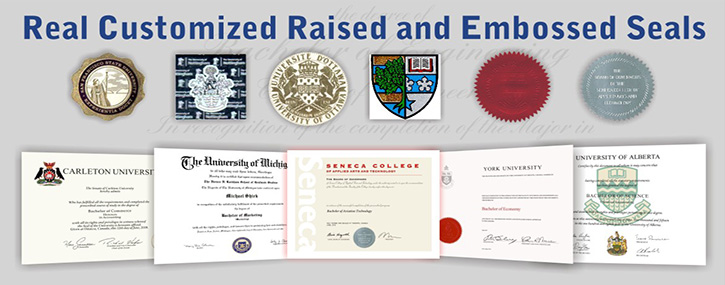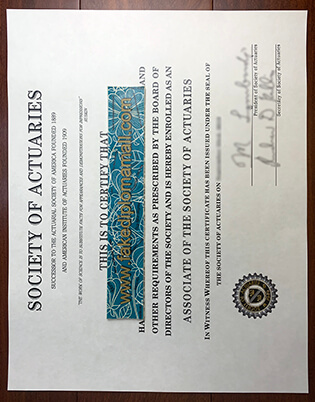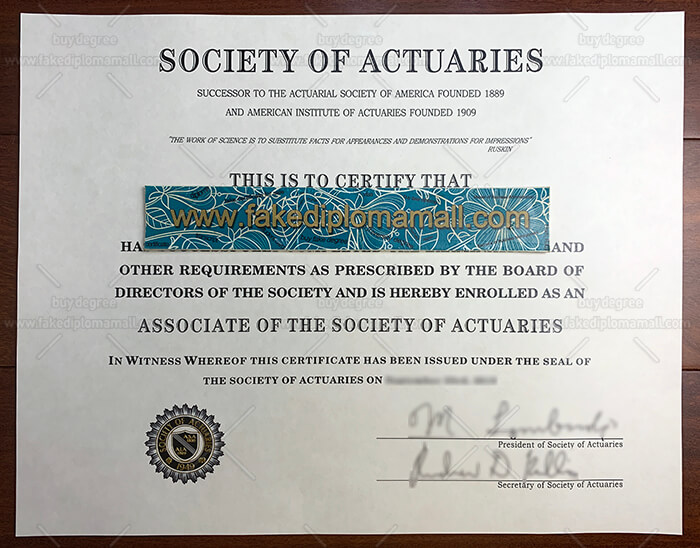The Society of Actuaries (SOA) in the United States is an internationally representative and authoritative organization with a large number of member actuaries. It was founded in 1889. Currently, there are about 30,000 members, and SOA has about 830 members in China. Mainland China members are mainly concentrated in Beijing, Shanghai, and Shenzhen. SOA is a global actuarial education and research institution that has developed into a professional association of actuaries in the world, providing excellent actuaries worldwide and awarding qualifications. Since an actuary is a very professional profession, it is generally necessary to pass a qualification test to determine the qualifications for employment. Canadian Actuarie Fake Certificate The internationally renowned actuarial societies include the Actuarial Society of North America, the Actuarial Society of the United Kingdom, the Actuarial Society of Japan and the Actuarial Society of Australia. Different actuaries associations have different qualifications and examination courses and systems. Among them, the most representative and authoritative international organization with the largest number of member actuaries is the Society of Actuaries (SOA) in the United States, which enjoys a high reputation. how to buy a fake SOA certificate, buy FSA certificate online, buy SOA fake diploma, buy a Fellow of Society of Actuaries certificate, buy Society of Actuaries fake certificate, There are approximately 16,500 regular and associate members. As an international actuarial education and research institution, American Actuaries Fake Certificate. SOA’s main task is to provide actuarial education programs in the areas of life insurance, health insurance, employee benefits, and pensions, and to improve the consultation and resolution of actuaries in the form of follow-up education involving uncertain events. Ability to finance, insurance, finance, and social issues.
Quasi-actuary stage
Course 1: Mathematical Foundations of Actuarial Science
Description: The purpose of this course is to develop knowledge about some basic mathematical tools and to develop the ability to assess risks from a quantitative perspective, especially to apply these tools to solve problems in actuarial science. And suppose that the students have mastered the basics of calculus, probability theory and risk management before learning this course.
Main contents and concepts: calculus; probability theory; risk management (including loss frequency; loss amount; retention amount; deductible; joint insurance and risk premium).
Lesson 2: Interest Theory, Economics, and Finance
Description: This course includes interest theory, intermediate microeconomics and macroeconomics, and the foundation of finance. Basic knowledge of calculus and probability theory is required before studying this course.
Main contents and concepts: interest theory; microeconomics; macroeconomics; financial basis.
Lesson 3: Actuarial Models on Risk (Actuarial Models)
Description: Through the study of this course, students will develop the basic knowledge of the actuarial model of random events and the application of these models in insurance and financial risks. Before you study this course, you need to be proficient in calculus, probability theory, buy SOA fake certificate, buy FSA fake certificate, how to be the Fellow of Society of Actuaries? and mathematical statistics. Participants are advised to study this course after passing Course 1 and 2.
Main content and concepts: insurance and other financial random events; survival models; population data analysis; quantitative analysis of the financial impact of random events.
Lesson 4: Actuarial Modeling
Description: This course provides an initial introduction to the basics of building models and important actuarial and statistical methods for modeling. Before learning this course, you should be familiar with the relevant content of calculus, linear algebra, probability theory, and mathematical statistics.
Main content and concepts: definition of the model; why and how to use the model; model advantages and disadvantages; deterministic and random models; model selection; input and output analysis; sensitivity test; experience and feedback of research results; regression analysis; Forecast; risk theory; reliability theory.
Lesson 5: Application of Basic Actuarial Principles
Description: This course provides product design, risk classification, pricing/rate determination/establishment of insurance funds, marketing, distribution, management and valuation. Coverage includes financial security plans, employee benefit plans, accident pension plans, government social insurance and pension plans, and some emerging application areas such as product liability, guarantee assessment, environmental maintenance costs, and manufacturing applications.
The course’s learning materials combine a variety of programs and coverage to demonstrate the consistency and variability of the application of actuarial principles across a variety of research areas. In order to encourage this learning method, the course considers the application of the subject in various fields when studying various actuarial topics, such as pricing, and not the other way around.
Main content and concepts: planning and product design; risk classification principles and techniques; principles of actuarial principles and practices in pricing, rate determination, the establishment of insurance funds and traditional and emerging applications; marketing, distribution, and management; liabilities and insurance Actuarial technology for fund evaluation.
Course 6: Finance and Investments (Finance and Investments)
Description: This course is an extension of the actuarial principles used in investment and asset-liability management. buy fake degree, buy fake diploma, buy fake certificate, buy American fake certificate, Upon completion of the course, participants will have an in-depth understanding of capital markets, investment vehicles, derivative securities and applications, portfolio management and asset-liability management.
Main contents and concepts: capital market and basic investment principles; asset-liability management.
Actuary stage
Lesson 7: Actuarial Model Application
Description: This course introduces the participants to the practical considerations for establishing an actuarial model. Students are required to have knowledge of the basic course. Part of the course is the same for all students. It is important to emphasize that the students should pay attention to the technologies and issues related to the field they are engaged in, which vary depending on the field in which the student is engaged.
Models can be used in many aspects of actuarial science, such as pricing/rate determination, insurance benefit design, asset/liability/capital management, asset and liability valuation, and dynamic solvency testing. Regardless of which aspect the model is used for, the steps are the same. This course will outline these steps. After completing the course, students will learn the modeling process and use it to solve some problems.
Main content and concepts: model design or selection; data input analysis; data output analysis; results comparison, testing, and feedback.
Lesson 8: Advanced Advanced Actuarial Practice.






